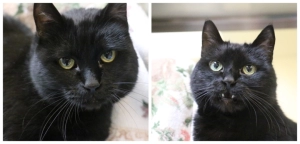Taking the mystery out about why cats scratch

Adoptable Amaya is a beautiful 11-year-old cat who is full of personality. There are two things Amaya loves most: attention and catnip! She even loves being brushed and will roll around on her sides and back, almost doing somersaults. What a silly girl! Amaya is on a special diet and is looking for an adopter who will continue her care. Learn more at pasadenahumane.org/adopt.
Our dear departed cat, Tubby, was “special,” bless his heart. We adopted him when he was a senior. I specifically asked to adopt the cat who had been in the shelter the longest and was least likely to be adopted. Tubby! was the answer I received from staff at the Virginia Beach SPCA.
Tubby’s name was, how should I say it…well-deserved. He was a BIG cat! He wasn’t fond of people, and he didn’t like animals either. I quickly learned that one thing he DID like (besides food, of course) was scratching — especially my upholstered furniture.
Cats love to scratch. In fact, scratching is an instinctual and healthy feline behavior. Cats scratch to sharpen their nails, relieve anxiety, stretch their muscles, get some exercise and establish their territory.
Scent glands in their paw pads release pheromones when cats scratch. Pheromones do not have an odor that people can smell, but other cats definitely take note. Cats feel safer and more comfortable in their environment when they mark it by scratching.
The good news is that if you provide your cats with a variety of appropriate scratching options, you can stop them from damaging your belongings.
Finding your cat’s favorite scratching surfaces may take some trial and error. Each cat has their own scratching preferences. Some cats prefer vertical surfaces, while others like horizontal scratchers.
Fortunately, you can choose from an abundance of cat scratchers. From big cat trees and standalone scratching posts to wall-mounted pads, corrugated cardboard, carpet mats, sisal ropes…the options are endless.
When selecting your cat’s new scratcher, size matters. Cats prefer large, sturdy items. They also like to stretch their whole body, so buy a scratcher that allows them to fully extend.
In terms of placement, cats generally prefer to scratch in socially significant areas of the house. While it might be tempting to hide your cat’s scratcher out of sight, they will be less likely to use it.
Once a new scratcher is in place, many curious cats will explore it immediately, while others may need some encouragement.
Try sprinkling some catnip or silvervine (Actinidia polygama, an alternative to catnip) to entice kitty over to play on or near the new scratcher. Reward your cat with a favorite treat for investigating or giving it a scratch or two.
Never punish your cat for scratching, even if you find them clawing in an inappropriate area. While using a spray bottle, noisemaker or physical punishment might work in the moment to deter your cat from scratching, it can create long-term behavioral problems such as litter box issues, avoidance or fear and aggression towards humans.
Instead of punishment, redirect your cat’s scratching. For example, if your kitty scratches the arm of your fabric sofa, try a vertical scratching post placed right next to the arm of the couch. If your cat prefers scratching horizontally on the back of the sofa, place a sturdy horizontal scratcher on the ground near the couch.
A final word about scratching — cats need their claws for grooming, balance, mobility, gripping and protection. Declawing should never be a solution to cat scratching. Declawing is an inhumane and incredibly painful procedure that leads to arthritis and, often, long-term litter box issues.
Pasadena Humane is launching a “purr-fect” new training class this June to help you learn more about scratching and getting your kitties off on the right paw.
“Kitten Kindergarten” is a fun, interactive experience that allows kittens ages 8 to 14 weeks to safely socialize with other kittens and new people in a clean, managed environment. Kitten parents will learn about litter box habits, mouthing, harness training and much more! Register at pasadenahumane.org/training
Dia DuVernet is president and CEO of Pasadena Humane.
This blog post originally appeared as a column in the Pasadena Star-News on May 19, 2023.


